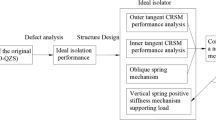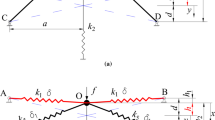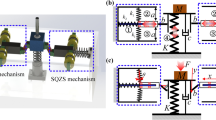Abstract
A quasi-zero-stiffness (QZS) isolator with the new design of positive stiffness configuration is proposed in this paper. The positive stiffness configuration, composed of a pair of torsion springs, oblique bars and linear bearings, exhibits beneficial nonlinearity. In parallel with the negative stiffness provided by the oblique bars connected to linear springs in the direction perpendicular to motion, it can expand the effective displacement range of QZS. In the static analysis, the force and stiffness of the system are derived. A nonlinear optimization is also conducted to determine the structural parameters. The dynamic characteristics are then analyzed through the Lagrange’s equation and averaging method. The displacement transmissibility is investigated through a numerical simulation. The results indicate a much better vibration isolation performance of the present design than that of the previous QZS isolator with the linear positive stiffness element.


















Similar content being viewed by others
Data availability
All data and codes generated during this study are included in the supplementary information files.
References
Wang, X., Liu, H., Chen, Y., Gao, P.: Beneficial stiffness design of a high-static-low-dynamic-stiffness vibration isolator based on static and dynamic analysis. Int. J. Mech. Sci. 142–143, 235–244 (2018). https://doi.org/10.1016/j.ijmecsci.2018.04.053
Liu, C., Yu, K.: A high-static–low-dynamic-stiffness vibration isolator with the auxiliary system. Nonlinear Dyn. 94, 1549–1567 (2018). https://doi.org/10.1007/s11071-018-4441-5
Bian, J., Jing, X.: Analysis and design of a novel and compact X-structured vibration isolation mount (X-Mount) with wider quasi-zero-stiffness range. Nonlinear Dyn. 101, 2195–2222 (2020). https://doi.org/10.1007/s11071-020-05878-y
Zhao, F., Ji, J.C., Ye, K., Luo, Q.: Increase of quasi-zero stiffness region using two pairs of oblique springs. Mech. Syst. Signal Process. (2020). https://doi.org/10.1016/j.ymssp.2020.106975
Deng, T., Wen, G., Ding, H., Lu, Z.Q., Chen, L.Q.: A bio-inspired isolator based on characteristics of quasi-zero stiffness and bird multi-layer neck. Mech. Syst. Signal Process. (2020). https://doi.org/10.1016/j.ymssp.2020.106967
Li, M., Cheng, W., Xie, R.: A quasi-zero-stiffness vibration isolator using a cam mechanism with user-defined profile. Int. J. Mech. Sci. (2021). https://doi.org/10.1016/j.ijmecsci.2020.105938
Le, T.D., Ahn, K.K.: A vibration isolation system in low frequency excitation region using negative stiffness structure for vehicle seat. J. Sound Vib. 330, 6311–6335 (2011). https://doi.org/10.1016/j.jsv.2011.07.039
Ding, H., Ji, J., Chen, L.Q.: Nonlinear vibration isolation for fluid-conveying pipes using quasi-zero stiffness characteristics. Mech. Syst. Signal Process. 121, 675–688 (2019). https://doi.org/10.1016/j.ymssp.2018.11.057
Zhu, G.N., Liu, J.Y., Cao, Q.J., Cheng, Y.F., Lu, Z.C., Zhu, Z.B.: A two degree of freedom stable quasi-zero stiffness prototype and its applications in aseismic engineering. Sci. China Technol. Sci. 63, 496–505 (2020). https://doi.org/10.1007/s11431-018-9524-2
Alsbushov, B.: Vibration Protecting and Measuring Systems with Quasi-Sero Stiffness. Hemisphere publishing corporation, New York (1989)
Carrella, A., Brennan, M.J., Waters, T.P.: Static analysis of a passive vibration isolator with quasi-zero-stiffness characteristic. J. Sound Vib. 301, 678–689 (2007). https://doi.org/10.1016/j.jsv.2006.10.011
Carrella, A., Brennan, M.J., Kovacic, I., Waters, T.P.: On the force transmissibility of a vibration isolator with quasi-zero-stiffness. J. Sound Vib. 322, 707–717 (2009). https://doi.org/10.1016/j.jsv.2008.11.034
Carrella, A., Brennan, M.J., Waters, T.P., Lopes, V.: Force and displacement transmissibility of a nonlinear isolator with high-static-low-dynamic-stiffness. Int. J. Mech. Sci. 55, 22–29 (2012). https://doi.org/10.1016/j.ijmecsci.2011.11.012
Gatti, G., Kovacic, I., Brennan, M.J.: On the response of a harmonically excited two degree-of-freedom system consisting of a linear and a nonlinear quasi-zero stiffness oscillator. J. Sound Vib. 329, 1823–1835 (2010). https://doi.org/10.1016/j.jsv.2009.11.019
Zhao, F., Ji, J., Ye, K., Luo, Q.: An innovative quasi-zero stiffness isolator with three pairs of oblique springs. Int. J. Mech. Sci. (2021). https://doi.org/10.1016/j.ijmecsci.2020.106093
Lan, C.C., Yang, S.A., Wu, Y.S.: Design and experiment of a compact quasi-zero-stiffness isolator capable of a wide range of loads. J. Sound Vib. 333, 4843–4858 (2014). https://doi.org/10.1016/j.jsv.2014.05.009
Lu, Z., Brennan, M.J., Chen, L.Q.: On the transmissibilities of nonlinear vibration isolation system. J. Sound Vib. 375, 28–37 (2016). https://doi.org/10.1016/j.jsv.2016.04.032
Wang, K., Zhou, J., Chang, Y., Ouyang, H., Xu, D., Yang, Y.: A nonlinear ultra-low-frequency vibration isolator with dual quasi-zero-stiffness mechanism. Nonlinear Dyn. 101, 755–773 (2020). https://doi.org/10.1007/s11071-020-05806-0
Liu, C., Yu, K.: Superharmonic resonance of the quasi-zero-stiffness vibration isolator and its effect on the isolation performance. Nonlinear Dyn. 100, 95–117 (2020). https://doi.org/10.1007/s11071-020-05509-6
Yang, J., Xiong, Y.P., Xing, J.T.: Dynamics and power flow behaviour of a nonlinear vibration isolation system with a negative stiffness mechanism. J. Sound Vib. 332, 167–183 (2013). https://doi.org/10.1016/j.jsv.2012.08.010
Huang, X., Liu, X., Sun, J., Zhang, Z., Hua, H.: Effect of the system imperfections on the dynamic response of a high-static-low-dynamic stiffness vibration isolator. Nonlinear Dyn. 76, 1157–1167 (2014). https://doi.org/10.1007/s11071-013-1199-7
Huang, X., Liu, X., Hua, H.: Effects of stiffness and load imperfection on the isolation performance of a high-static-low-dynamic-stiffness non-linear isolator under base displacement excitation. Int. J. Non. Linear. Mech. 65, 32–43 (2014). https://doi.org/10.1016/j.ijnonlinmec.2014.04.011
Liu, X., Huang, X., Hua, H.: On the characteristics of a quasi-zero stiffness isolator using Euler buckled beam as negative stiffness corrector. J. Sound Vib. 332, 3359–3376 (2013). https://doi.org/10.1016/j.jsv.2012.10.037
Huang, X., Chen, Y., Hua, H., Liu, X., Zhang, Z.: Shock isolation performance of a nonlinear isolator using Euler buckled beam as negative stiffness corrector: Theoretical and experimental study. J. Sound Vib. 345, 178–196 (2015). https://doi.org/10.1016/j.jsv.2015.02.001
Zhao, L., Yu, Y., Zhou, C., Yang, F.: Modelling and validation of a seat suspension with rubber spring for off-road vehicles. JVC/J. Vib. Control. 24, 4110–4121 (2018). https://doi.org/10.1177/1077546317719348
Cheng, C., Li, S., Wang, Y., Jiang, X.: Force and displacement transmissibility of a quasi-zero stiffness vibration isolator with geometric nonlinear damping. Nonlinear Dyn. 87, 2267–2279 (2017). https://doi.org/10.1007/s11071-016-3188-0
Zhang, L., Zhao, C., Qian, F., Dhupia, J.S., Wu, M.: A variable parameter ambient vibration control method based on quasi-zero stiffness in robotic drilling systems. Machines. (2021). https://doi.org/10.3390/machines9030067
Sun, X., Xu, J., Jing, X., Cheng, L.: Beneficial performance of a quasi-zero-stiffness vibration isolator with time-delayed active control. Int. J. Mech. Sci. 82, 32–40 (2014). https://doi.org/10.1016/j.ijmecsci.2014.03.002
Zhao, F., Cao, S., Luo, Q., Li, L., Ji, J.: Practical design of the QZS isolator with one pair of oblique bars by considering pre-compression and low-dynamic stiffness. Nonlinear Dyn. 108, 3313–3330 (2022). https://doi.org/10.1007/s11071-022-07368-9
Zheng, Y., Zhang, X., Luo, Y., Zhang, Y., Xie, S.: Analytical study of a quasi-zero stiffness coupling using a torsion magnetic spring with negative stiffness. Mech. Syst. Signal Process. 100, 135–151 (2018). https://doi.org/10.1016/j.ymssp.2017.07.028
Zhou, Y., Chen, P., Mosqueda, G.: Analytical and numerical investigation of quasi-zero stiffness vertical isolation system. J. Eng. Mech. 145, 04019035 (2019). https://doi.org/10.1061/(asce)em.1943-7889.0001611
Papaioannou, G., Voutsinas, A., Koulocheris, D.: Optimal design of passenger vehicle seat with the use of negative stiffness elements. Proc. Inst. Mech. Eng. Part D J. Automob. Eng. 234, 610–629 (2020). https://doi.org/10.1177/0954407019854879
Le, T.D., Ahn, K.K.: Experimental investigation of a vibration isolation system using negative stiffness structure. Int. J. Mech. Sci. 70, 99–112 (2013). https://doi.org/10.1016/j.ijmecsci.2013.02.009
Acknowledgements
This work was supported by the National Natural Science Foundation of China (Grant No. 12002151) and the National Science Foundation of Jiangsu Province (Grant No. BK20190664).
Author information
Authors and Affiliations
Corresponding author
Ethics declarations
Conflict of interest
The authors declare that they have no conflicts of interest.
Additional information
Publisher's Note
Springer Nature remains neutral with regard to jurisdictional claims in published maps and institutional affiliations.
Rights and permissions
Springer Nature or its licensor (e.g. a society or other partner) holds exclusive rights to this article under a publishing agreement with the author(s) or other rightsholder(s); author self-archiving of the accepted manuscript version of this article is solely governed by the terms of such publishing agreement and applicable law.
About this article
Cite this article
Chen, T., Zheng, Y., Song, L. et al. Design of a new quasi-zero-stiffness isolator system with nonlinear positive stiffness configuration and its novel features. Nonlinear Dyn 111, 5141–5163 (2023). https://doi.org/10.1007/s11071-022-08116-9
Received:
Accepted:
Published:
Issue Date:
DOI: https://doi.org/10.1007/s11071-022-08116-9




